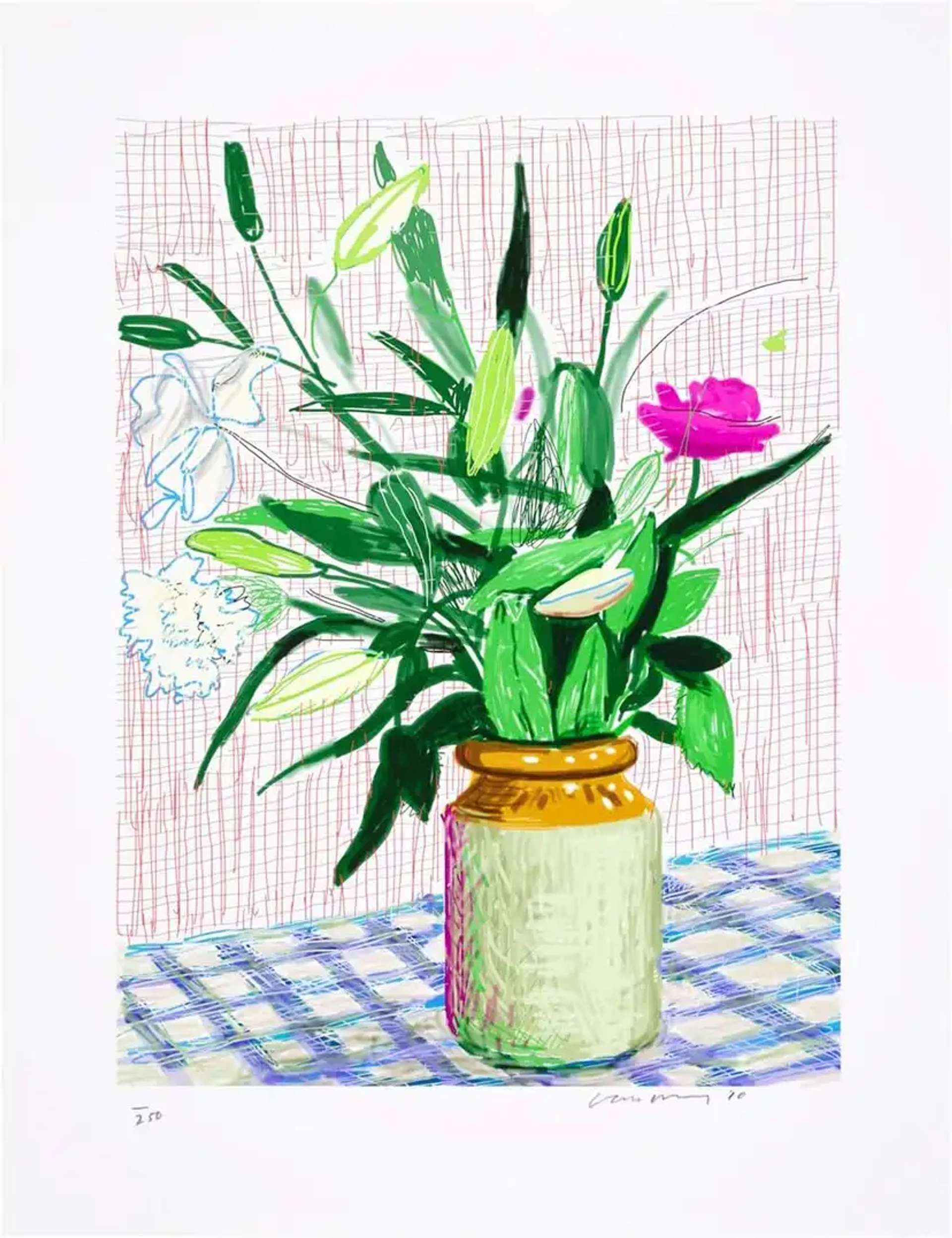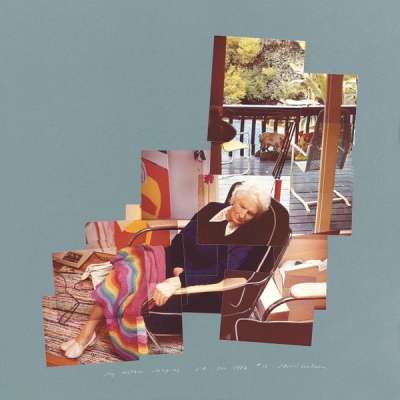 My Mother Sleeping, Los Angeles © David Hockney 1982
My Mother Sleeping, Los Angeles © David Hockney 1982
David Hockney
654 works
David Hockney, a seminal figure in the Pop Art movement, revolutionised visual art with his inventive technique of creating joiners. This method, which involves piecing together a mosaic of photographs to form a cohesive image, challenges and transcends traditional perspectives in both photography and painting. By fragmenting and then reassembling the visual field, Hockney's joiners disrupt conventional viewpoints, inviting a deeper exploration into the intricacies of perception and representation. This introduction sets the stage to dive into the impact of Hockney's joiners, underscoring their significance in reshaping contemporary art and photography, and illuminating their influence on artists and photographers alike.
The Genesis of Hockney's Joiners
The beginning of Hockney's joiners can be traced back to the early 1980s, stemming from his deep-seated dissatisfaction with the limitations of traditional photography and its confinement to a single perspective. Hockney's pioneering spirit and his constant quest for innovation led him to explore the possibilities of capturing the essence of time and space in a manner that more closely mirrored human vision and experience.
Hockney's initial inspiration for the joiners came from his observation of the way we perceive the world around us—not as a single, frozen moment, but as a complex amalgamation of views, perspectives, and moments. He was intrigued by the idea that conventional photographs could only provide a limited, static view of a subject and sought a more dynamic method of representation that could encompass the fluidity and multiplicity of seeing.
The development of the joiner technique began with what Hockney refers to as photographic drawings, where he started experimenting with laying out Polaroid snapshots on a surface to create a composite image. One of the earliest and most significant pieces that marked the evolution of this technique was My Mother, Bolton Abbey, Yorkshire, Nov. 1982. This piece consisted of multiple Polaroid shots arranged to form a single, cohesive image of his mother sitting in the Yorkshire countryside. The result was a vivid, multi-dimensional representation that captured not just the visual essence of the scene but also the temporal experience of the moment.
Technique and Execution
Hockney's joiners are a fascinating exploration of perspective, time, and space through the medium of photography. This technique involves the meticulous assembly of multiple photographs to create a single, composite image. Hockney's approach begins with the selection of a subject that is often mundane or familiar, such as a living room, a friend, or a landscape. This choice underscores his interest in how we perceive and interpret the space and time around us.
The execution of the joiners is both methodical and intuitive. Hockney takes numerous photographs from different angles and perspectives, focusing on various details of the scene. He then pieces these photographs together, akin to a jigsaw puzzle, but without the intention of seamlessly blending them into a traditional photographic panorama. Instead, Hockney embraces the disjointed edges, the overlapping images, and the shifts in perspective and scale. This method highlights the differences in time and viewpoint within the same space, challenging the viewer's perception and encouraging them to see the subject in a new way.
Composition, colour, and perspective are crucial elements in Hockney's joiners. He uses these elements to guide the viewer's eye through the image, creating a narrative or a sense of movement. The composition is often non-linear, reflecting how our eyes move across a scene rather than capturing it in a single glance. Colour is used to create mood, depth, and emphasis, drawing attention to specific parts of the image or harmonising the overall composition. Perspective is perhaps the most revolutionary aspect of Hockney's technique. By combining photographs taken from multiple viewpoints, Hockney constructs a dynamic and multifaceted perspective that diverges from traditional single-point perspective, thereby offering a more holistic and immersive experience of space and time.
Joiners: Beyond Photography
The joiner technique, with its emphasis on assembling multiple viewpoints to create a more dynamic and holistic representation of a scene, naturally extended into Hockney's painting. His paintings, particularly those following the development of the joiners, often reflect a similar approach to composition—where different perspectives are merged into a single canvas, challenging traditional, single-point perspective. This approach can be seen in works like Grand Canyon, Arizona With My Shadow, where Hockney uses colour, light, and form to piece together various perspectives of the Grand Canyon, creating a vast, immersive landscape that invites viewers to explore the scene from multiple vantage points.
Hockney's exploration of perspective took a significant turn with the advent of digital technology, particularly with his adoption of the iPad as a medium for creating art. The iPad offered Hockney a new platform to further investigate the themes central to his joiners but with the added flexibility of digital tools. His digital pieces, much like his photographic joiners, are characterised by their exploration of space, time, and perspective. However, the digital medium allowed Hockney to experiment with these themes in more fluid and spontaneous ways.
The continuity between Hockney's photographic joiners and his later digital pieces is evident in his approach to composition and perspective. Both mediums allowed Hockney to break down the scene into component parts—whether through the assembly of individual photographs or through the layering of digital brushstrokes—and then reassemble them to construct a more comprehensive and engaging representation of the subject. This method highlights Hockney's enduring interest in how we perceive and understand space and time, pushing the boundaries of visual representation.
Cubism’s Influence on Hockney’s Joiners
Cubism, a groundbreaking art movement birthed in the early 20th century, fundamentally altered the artistic landscape, introducing a novel perspective on representation and perception. Pioneered by luminaries Pablo Picasso and Georges Braque, Cubism sought to challenge the singularity of perspective, advocating for a multifaceted view of subjects. Through the deconstruction of objects into basic geometric forms and their subsequent reassembly, Cubism unveiled a new visual lexicon that emphasised the subject's essence from diverse viewpoints, thereby questioning the traditional, fixed perspective paradigm.
In his joiners, Hockney's engagement with Cubism is clearly evident, reflecting a deliberate integration of fragmentation and multiple perspectives into a cohesive visual experience. This technique allowed him to weave together distinct snapshots into a unified image that challenges and expands the viewer's perception. By adopting Cubist principles, Hockney’s joiners break the constraints of space, offering a dynamic and enriched representation of scenes that revisit Cubism’s holistic approach to its subjects.
Reshaping the Artistic Landscape: Hockney’s Legacy in Modern Photography
The legacy of Hockney’s joiners in modern photography is evident in the growing interest in non-linear narratives and the exploration of time and space. Hockney demonstrated that photography could go beyond capturing a moment in time to evoke a sense of movement and temporality, a concept that has inspired photographers to experiment with sequential imagery, collage techniques, and fragmented compositions. This approach allows for a more complex and layered storytelling method, where the narrative unfolds through a series of images rather than a single snapshot, offering a richer, more nuanced exploration of subjects.
Hockney's influence extends to the way contemporary artists engage with digital technology. The seamless blend of traditional photography with digital manipulation seen in Hockney’s later works prefigured the current trend where digital tools are used to deconstruct and reconstruct images. Artists now commonly employ software to splice, overlay, and juxtapose photographs, creating composite images that challenge our perceptions of reality, much in the way Hockney’s joiners did.
Hockney’s experimentation with perspective has also encouraged artists to explore the spatial possibilities within their work, pushing them to consider how multiple perspectives can be integrated to create a more immersive experience. This has led to innovative uses of space within photographic compositions, as well as in installations and mixed media art, where the physical layout of images in a gallery or public space can alter the viewer’s experience and interpretation of the work.
In the realm of education and critical theory, Hockney's joiners have provided a rich subject for analysis, influencing how photography and art are taught and critiqued. His work encourages a critical examination of the role of the viewer, the relationship between artist and subject, and the ways in which art can alter perception. As a result, Hockney’s joiners have become a touchstone for discussions about the nature of representation, the fluidity of time, and the construction of visual narratives.
Looking forward, Hockney's legacy in reshaping the artistic landscape continues to inspire a new generation of artists and photographers who are pushing the boundaries of their mediums. By embracing the principles of experimentation, narrative complexity, and the exploration of perspective that Hockney championed, contemporary creators are expanding the possibilities of visual art. Hockney's joiners, therefore, stand not just as a hallmark of innovation in their own right, but as a beacon for ongoing exploration and reinterpretation in the evolving field of art and photography.
The Legacy of Hockney's Visionary Joiners
Hockney's joiners, with their intricate assembly of moments and perspectives, have undeniably cemented a legacy that transcends the traditional boundaries of art and photography. By challenging and expanding the conventional notions of space, time, and narrative, Hockney has not only redefined visual representation but has also provided a new lens through which we can view the world around us. His innovative approach to piecing together fragmented realities invites viewers to engage in a more profound, multi-dimensional exploration of their surroundings, echoing the complexities of human perception and memory.






















